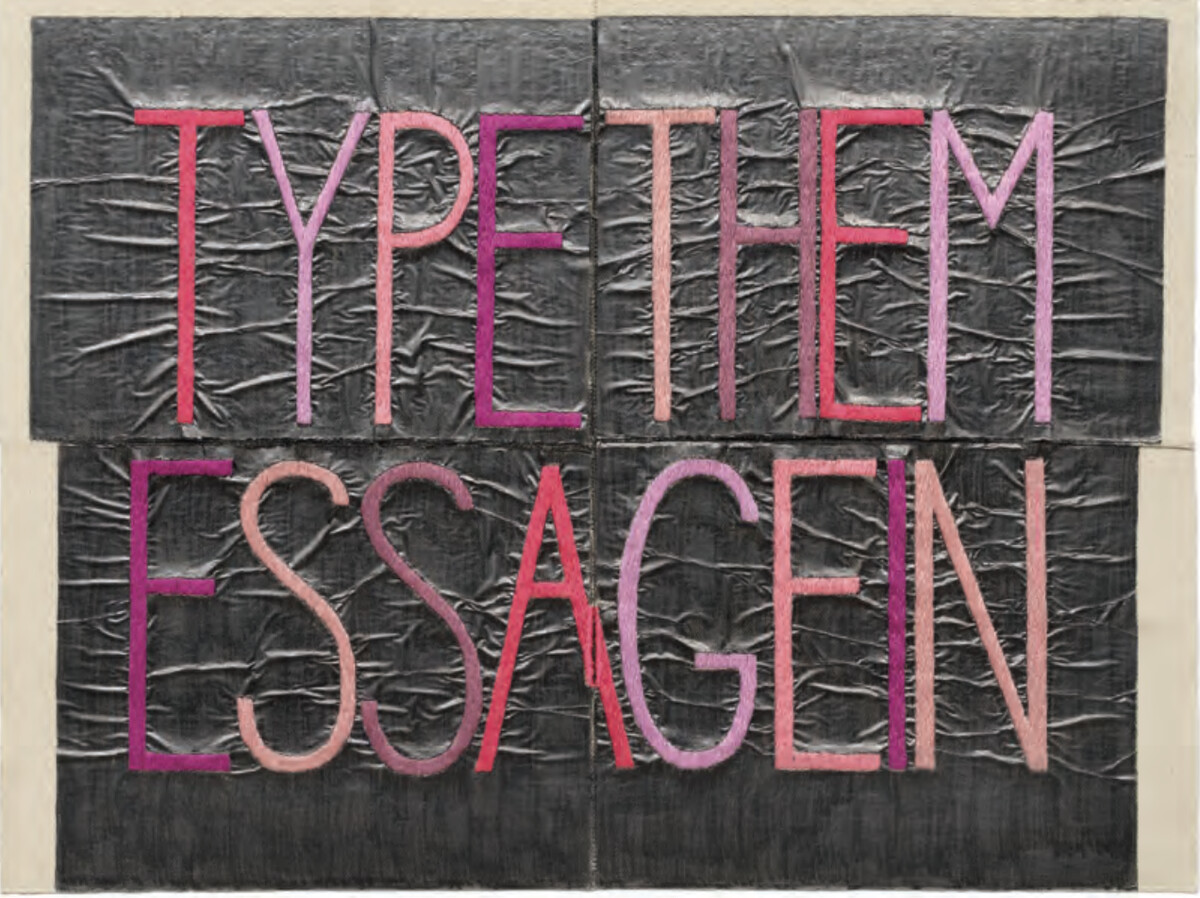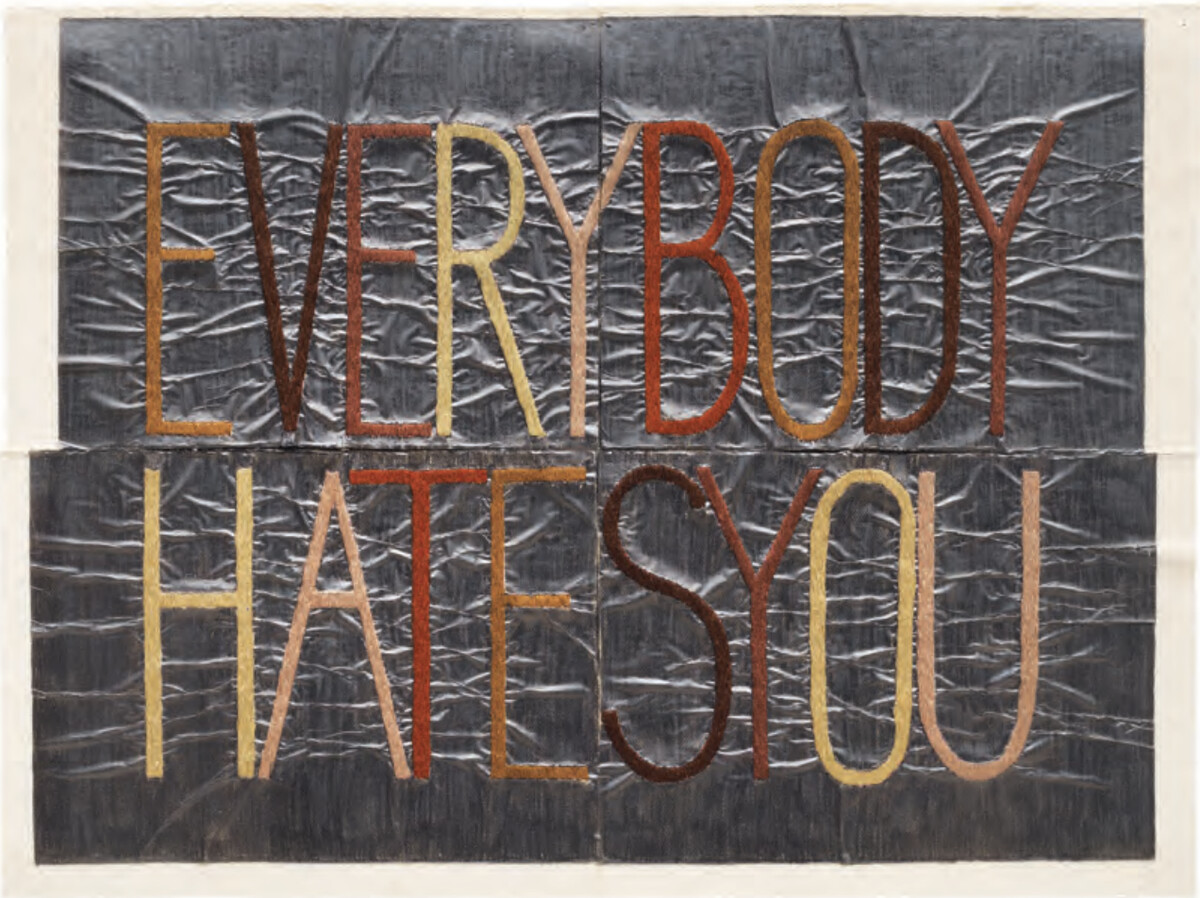
Pace, timing, and place can be everything. The work you’re
seeing has been deliberately slowed down. It is figuratively and
literally drawn from longer texts—the printed obituaries are
typography, these sewn works are lettering. Neither multiple
nor mass-produced, they are both serial and unique. Even when
repeated letters are traced over and over, they are then often
split, sometimes vertically rent to fit the space at hand, and
always striped in tints and shades of varying hues. What at first
might look uniform, or like a strictly coordinated practice of
categorization, soon grows more complex, messier, and wrinkled
around the edges as the graphite on pierced paper puckers up,
embellishing the embroidered letterforms.
The visual work on the preceding pages is text—textual, victual,
ritual, actual, factual, contractual, conceptual, eventual, spiritual,
virtual, accentual, effectual, intellectual, habitual, perceptual,
perpetual. Two nouns plus fourteen adjectives minus several
ambiguities equals hmmm. You can try to sort it out, but perhaps
this puzzle prefers to remain unsolved.
At first my eye catches specific letters, then it assembles a word
here and there, in a repeatedly foiled attempt at decoding a
set phrase; finally, I see it. Sometimes it comes in the form of a
command: type the message in; use these words. Sometimes it’s
a straight observation: there is no return; everybody hates you;
he carries the snow. Sometimes it’s a caption or description: the
incident and its aftermath; the greatest and dirtiest of them all; his
last website; another uncanny illusionistic effect. And sometimes it’s
a cliffhanger: in the time it took to ask the question … .

And now I’m asking so many questions, and getting lots of
answers, but not all the answers. Let’s take the cliffhanger as an
example. Who? “Shakuntala Devi, 83, ‘Human Computer’.” What?
“She could give you the cube root of 188,132,517—or almost any
other number—in the time it took to ask the question.” Where?
“In Bangalore, India.” When? “On Sunday” (April 22, 2013). How?
“Through intense practice as a child.” Why? I dare you to try and
answer this one.
These are distillations, more than redactions. They result
from a process of finding, extracting, and then transcribing
and rewriting the words. Each step is a transformation. It’s
a distinction as nuanced as the colors now floating before
us, forming quandaries, indicating a life’s work, on shiny
quadrants of steely grey. What are these colors? Maybe they’re
synesthetic biographies, maybe they’re latent prose poems,
maybe a rainbow reconfigured. How are these colors? Primary,
secondary, and tertiary, perhaps they’re also arbitrary, honorary,
or just plain wary. Their existence springs from functional,
idiosyncratic classifications determined by the artist’s own rubric.
They implicitly point to the absurdity of categorization and its
inevitable tendency to omit the essential: esteemed or infamous,
no specific life can ever be reduced to a single story; no single,
easy explanation can be teased out of an ambitious, polyvalent
work of art.
Turning to consider the graphite installations in her Evidence
of the Material World series—related to, yet not part of, the
Words from Obituaries series—I’m reminded of the artist’s
“commitment to ephemerality.” Ars longa, vita brevis: the
supposed permanence of art and the incontrovertibly fleeting
nature of life are reflected back at us here, with vibrant bits of
meaning punching through the darkness to jump out at our eyes,
tease our minds, and set the gears of meaning into motion.
Returning to the basic questions: Who? You and me and Dianna
Frid. What? These pieces, these phrases, these lives. Where? Alan
Koppel Gallery, Chicago. When? Friday, September 13, to Friday,
November 15, 2019. How? By distillation, intense practice, and a
miracle. Why? Let’s let you answer this time.
